

Example \(\PageIndex<1>\) Solve the equation \(2x +3y = 6\) for \(y\) and plot the result. Solution First we solve the equation \(2x +3y = 6\) for \(y\). Begin by isolating all terms containing y on one side of the equation, moving or keeping all the remaining terms on the other side of the equation. \[\begin 2x+3y &= 6 \quad \color \text < Original equation. >\\ 2x+3y-2x &= 6-2x \quad \color \text < Subtract >2x \text < from both sides. >\\ 3y &= 6-2x \quad \color \text < Simplify. >\\ \dfrac &= \dfrac \quad \color \text < Divide both sides by >3 \end \nonumber \]
Note Just as multiplication is distributive with respect to addition \[a(b + c)=ab + ac \nonumber \]so too is division distributive with respect to addition.\[\dfrac=\dfrac+\dfrac \nonumber \]
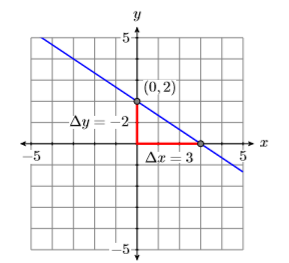
When dividing a sum or a difference by a number, we use the distributive property and divide both terms by that number. \[\begin
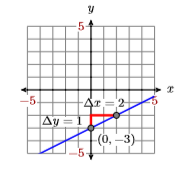
Exercise \(\PageIndex<1>\) Add exercises text here. Answer
FAct The graph of the equation \(Ax + By = C\), is a line.The form \(Ax + By = C\), where \(A\), \(B\), and \(C\) are integers, and \(A ≥ 0\), is called the standard form of a line.
We’ve already transformed a couple of equations in standard form into slopeintercept form. Let’s reverse the process and place an equation in slope intercept form into standard form.
Given the graph of the line in Figure \(\PageIndex\), find the equation Given the graph of the line below, find the equation of the line in standard form.
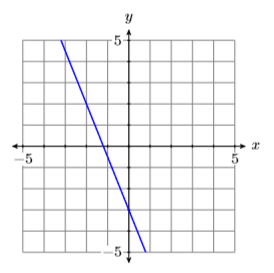
Solution
The line intercepts the \(y\)-axis at \((0,−3)\). From \((0,−3)\), move up \(5\) units, then left \(2\) units. Thus, the line has slope \(\Delta y / \Delta x=-5 / 2\) (see Figure \(\PageIndex\)). Substitute \(−5/2\) form and \(−3\) for \(b\) in the slope-intercept form of the line.
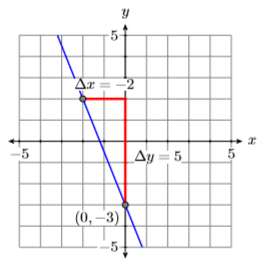
To put this result in standard form \(Ax + By = C\), first clear the fractions by multiplying both sides by the common denominator.
\[\begin 2y &= 2\left[-\dfrac x-3\right] \quad \color \text < Multiply both sides by >2 \\ 2y &= 2\left[-\dfrac x\right]-2[3] \quad \color \text < Distribute the >2 \\ 2y &= -5x-6 \quad \color \text < Multiply. >\end \nonumber \]
That clears the fractions. To put this last result in the form \(Ax+By = C\), we need to move the term \(−5x\) to the other side of the equation.
\[\begin 5x+2y &= -5x-6+5x \quad \color \text < Add >5x \text < to both sides. >\\ 5x+2y &= -6 \quad \color\text < Simplify. >\end \nonumber \]
Thus, the standard form of the line is \(5x +2y = −6\). Note that all the coefficients are integers and the terms are arranged in the order \(Ax+By = C\), with \(A ≥0\).
Given the graph of the line below, find the equation of the line in standard form.
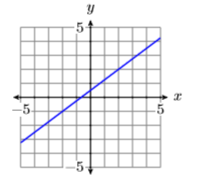
Answer
Let’s do an example where we have to put the point-slope form of a line in standard form.
Sketch the line passing through the points \((−3,−4)\) and \((1,2)\), then find the equation of the line in standard form.
Solution
Plot the points (−3,−4) and (1,2), then draw a line through them (see Figure \(\PageIndex\)).
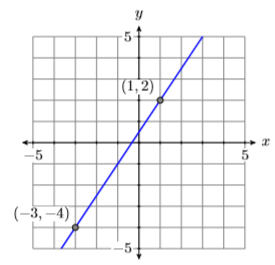
Use the points \((−3,−4)\) and \((1,2)\) to calculate the slope.
Let’s substitute \(\left(x_, y_\right)=(1,2)\) and \(m =3 /2\) in the point-slope form of the line. (Note: Substituting \(\left(x_, y_\right)=(-3,-4)\) and \(m =3 /2\) would yield the same answer.)
\[\begin y-y_ &= m\left(x-x_\right) \quad \color \text < Point-slope form. >\\ y-2 &= \dfrac(x-1) \quad \color \text < Substitute: >3 / 2 \text < for >m, 1 \text < for >x_ \end \nonumber \]
The question requests that our final answer be presented in standard form. First we clear the fractions.
\[\begin y-2 &= \dfrac x-\dfrac \quad \color \text < Distribute the >3 / 2 \\ 2[y-2] &= 2\left[\dfrac x-\dfrac\right] \quad \color \text < Multiply both sides by >2 \\ 2y-2[2] &= 2\left[\dfrac x\right]-2\left[\dfrac\right] \quad \color \text < Distribute the >2 \\ 2y-4 &= 3 x-3 \quad \color \text < Multiply. >\end \nonumber \]
Now that we’ve cleared the fractions, we must order the terms in the form \(Ax+By = C\). We need to move the term \(3x\) to the other side of the equation.
To put this in the form \(Ax + By = C\), we need to move the term \(−4\) to the other side of the equation.
\[\begin -3x+2y-4+4 &= -3+4 \quad \color \text < Add >4 \text < to both sides. >\\ -3x+2y &= 1 \quad \color \text < Simplify. >\end \nonumber \]
It appears that \(−3x+2y = 1\) is in the form \(Ax +By = C\). However, standard form requires that \(A ≥ 0\). We have \(A = −3\). To fix this, we multiply both sides by \(−1\).
Thus, the equation of the line in standard form is \(3x−2y =−1\).
If we fail to reduce the slope to lowest terms, then the equation of the line would be: \[y-2=\dfrac(x-1) \nonumber \]
Multiplying both sides by \(4\) would give us the result \[4y−8=6x−6 \nonumber \]or equivalently: \[−6x +4y =2 \nonumber \]
This doesn’t look like the same answer, but if we divide both sides by \(−2\), we do get the same result. \[3x−2y = −1 \nonumber \]
This shows the importance of requiring \(A ≥ 0\) and “reducing” the coefficients \(A\), \(B\), and \(C\). It allows us to compare our answer with our colleagues or the answers presented in this textbook.
Find the standard form of the equation of the line that passes through the points \((−2,4)\) and \((3,−3)\).
Answer
We’ve studied the \(y\)-intercept, the point where the graph crosses the \(y\)-axis, but equally important are the \(x\)-intercepts, the points where the graph crosses the \(x\)-axis.
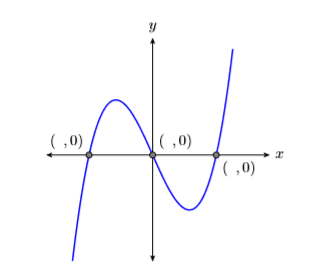
In Figure \(\PageIndex\), the graph crosses the \(x\)-axis three times. Each of these crossing points is called an \(x\)-intercept. Note that each of these \(x\)-intercepts has a \(y\)-coordinate equal to zero. This leads to the following rule.
\(x\) Intercepts
To find the \(x\)-intercepts of the graph of an equation, substitute \(y = 0\) into the equation and solve for \(x\).
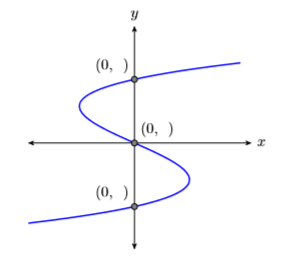
Similarly, the graph in Figure \(\PageIndex\) crosses the \(y\)-axis three times. Each of these crossing points is called a \(y\)-intercept. Note that each of these \(y\)-intercepts has an \(x\)-coordinate equal to zero. This leads to the following rule.
To find the \(y\)-intercepts of the graph of an equation, substitute \(x = 0\) into the equation and solve for \(y\).
Let’s put these rules for finding intercepts to work.
Find the \(x\)- and \(y\)-intercepts of the line having equation \(2x−3y = 6\). Plot the intercepts and draw the line.
Solution
We know that the graph of \(2x−3y = 6\) is a line. Furthermore, two points completely determine a line. This means that we need only plot the \(x\)- and \(y\)-intercepts, then draw a line through them.
To find the \(x\)-intercept of \(2x−3y = 6\), substitute \(0\) for \(y\) and solve for \(x\).
\[\begin 2 x-3 y &=6 \\ 2 x-3(0) &=6 \\ 2 x &=6 \\ \dfrac &=\dfrac \\ x &=3 \end \nonumber \]
Thus, the \(x\)-intercept of the line is \((3,0)\).
To find the \(y\)-intercept of \(2x−3y = 6\), substitute \(0\) for \(x\) and solve for \(y\).
\[\begin 2 x-3 y &=6 \\ 2(0)-3 y &=6 \\-3 y &=6 \\ \frac &=\frac \\ y &=-2 \end \nonumber \]
Thus, the \(y\)-intercept of the line is \((0,−2)\).
Plot the \(x\)-intercept \((3,0)\) and the \(y\)-intercept \((0,−2)\) and draw a line through them (see Figure \(\PageIndex\)).
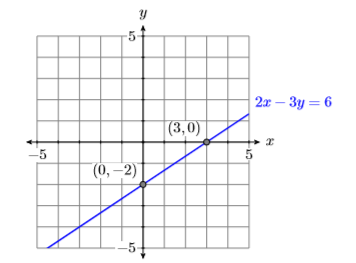
Find the \(x\)- and \(y\)-intercepts of the line having equation \(3x +4y = −12\). Plot the intercepts and draw the line.
Answer
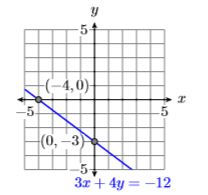
Sketch the line \(4x +3 y = 12\), then sketch the line through the point \((−2,−2)\) that is perpendicular to the line \(4x +3 y = 12\). Find the equation of this perpendicular line.
Solution
Let’s first find the \(x\)- and \(y\)-intercepts of the line \(4x +3y = 12\).
To find the \(x\)-intercept of the line \(4x+3y = 12\), substitute \(0\) for \(y\) and solve for \(x\).
\[\begin 4 x+3 y &=12 \\ 4 x+3(0) &=12 \\ 4 x &=12 \\ \dfrac &=\dfrac \\ x &=3 \end \nonumber \]
Thus, the \(x\)-intercept of the line is \((3,0)\).
To find the \(y\)-intercept of the line \(4x+3y = 12\), substitute \(0\) for \(x\) and solve for \(y\).
\[\begin 4 x+3 y &=12 \\ 4(0)+3 y &=12 \\ 3 y &=12 \\ \dfrac &=\dfrac \\ y &=4 \end \nonumber \]
Thus, the \(y\)-intercept of the line is \((0,4)\).
Plot the intercepts and draw a line through them. Note that it is clear from the graph that the slope of the line \(3x +4y = 12\) is \(−4/3\) (see Figure \(\PageIndex\)).
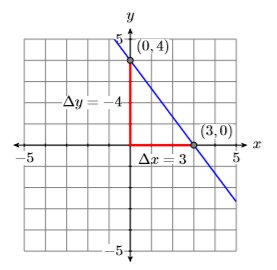
You could also solve for \(y\) to put \(3x +4 y = 12\) in slope intercept form in order to determine the slope.
Because the slope of \(3x+4y = 12\) is \(−4/3\), the slope of a line perpendicular to \(3x +4y = 12\) will be the negative reciprocal of \(−4/3\), namely \(3/4\). Our perpendicular line has to pass through the point \((−2,−2)\). Start at \((−2,−2)\), move \(3\) units upward, then \(4\) units to the right, then draw the line. It should appear to be perpendicular to the line \(3x +4y = 12\) (see Figure \(\PageIndex\)).
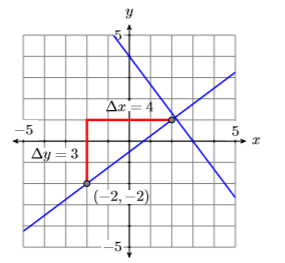
Finally, use the point-slope form, \(m =3 /4\), and \(\left(x_, y_\right)=(-2,-2)\) to determine the equation of the perpendicular line.
Let’s place our answer in standard form. Clear the fractions.
\[\begin y+2 &= \dfrac x+\dfrac \quad \color \text < Distribute >3 / 4 \\ 4[y+2] &= 4\left[\dfrac x+\dfrac\right] \quad \color \text < Multiply both sides by >4 \\ 4y+4[2] &= 4\left[\dfrac x\right]+4\left[\dfrac\right] \quad \color \text < Distribute the >4 \\ 4y+8 &= 3x+6 \quad \color \text < Multiply. >\end \nonumber \]
Rearrange the terms to put them in the order \(Ax + By = C\).
Hence, the equation of the perpendicular line is \(3x−4y = 2\).
Find the equation of the line that passes through the point \((3,2)\) and is perpendicular to the line \(6x−5y = 15\).
Answer
Here we keep an earlier promise to address what happens to the standard form \(Ax + By = C\) when either \(A = 0\) or \(B = 0\). For example, the form \(3x = 6\), when compared with the standard form \(Ax + By = C\), has \(B = 0\). Similarly, the form \(2y = −12\), when compared with the standard form \(Ax + By = C\), has \(A = 0\). Of course, \(3 x = 6\) can be simplified to \(x = 2\) and \(2 y = −12\) can be simplified to \(y = −6\). Thus, if either \(A = 0\) or \(B = 0\), the standard form \(\)Ax + By = C takes the form \(x = a\) and \(y = b\), respectively.
As we will see in the next example, the form \(x = a\) produces a vertical line, while the form \(y = b\) produces a horizontal line.
Sketch the graphs of \(x = 3\) and \(y = −3\).
Solution
To sketch the graph of \(x = 3\), recall that the graph of an equation is the set of all points that satisfy the equation. Hence, to draw the graph of \(x = 3\), we must plot all of the points that satisfy the equation \(x = 3\); that is, we must plot all of the points that have an \(x\)-coordinate equal to \(3\). The result is shown in Figure \(\PageIndex\).
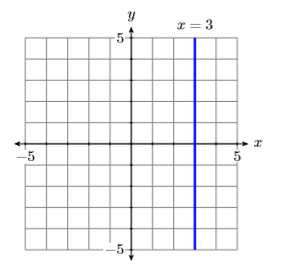
Secondly, to sketch the graph of \(y = −3\), we plot all points having a \(y\)-coordinate equal to \(−3\). The result is shown in Figure \(\PageIndex\).
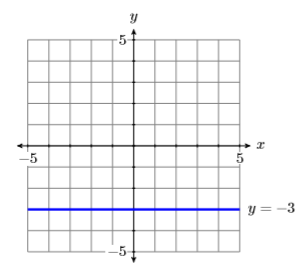
A couple of comments are in order regarding the lines in Figures \(\PageIndex\) and \(\PageIndex\).
However, it is far easier to just look at the line in Figures \(\PageIndex\) and note that it is the collection of all points \((x,y)\) with \(y = 3\).
Sketch the graphs of \(x = −2\) and \(y = 2\).
Answer
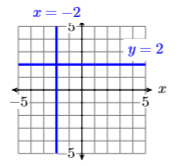
This page titled 3.6: Standard Form of a Line is shared under a CC BY-NC-ND 3.0 license and was authored, remixed, and/or curated by David Arnold via source content that was edited to the style and standards of the LibreTexts platform.